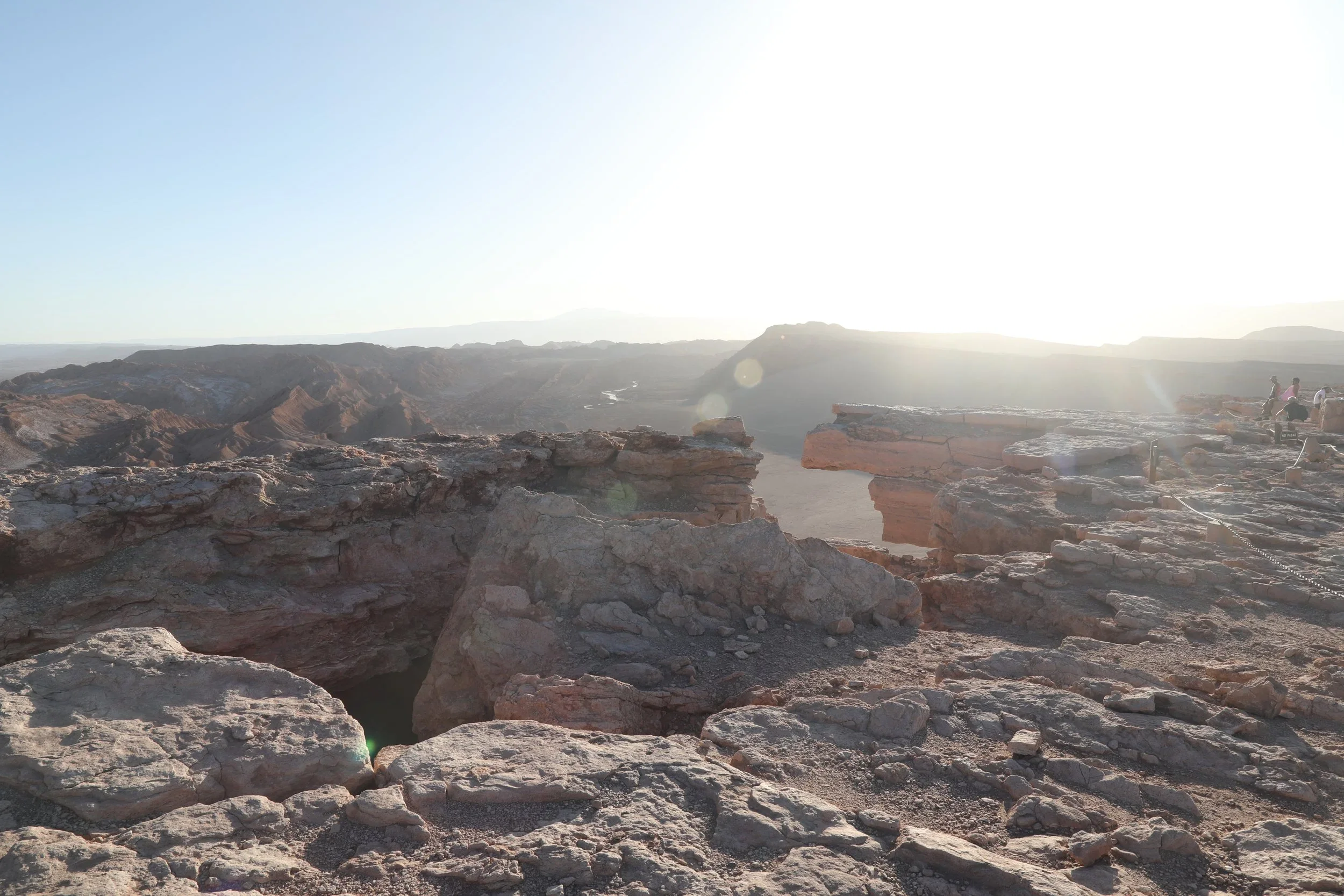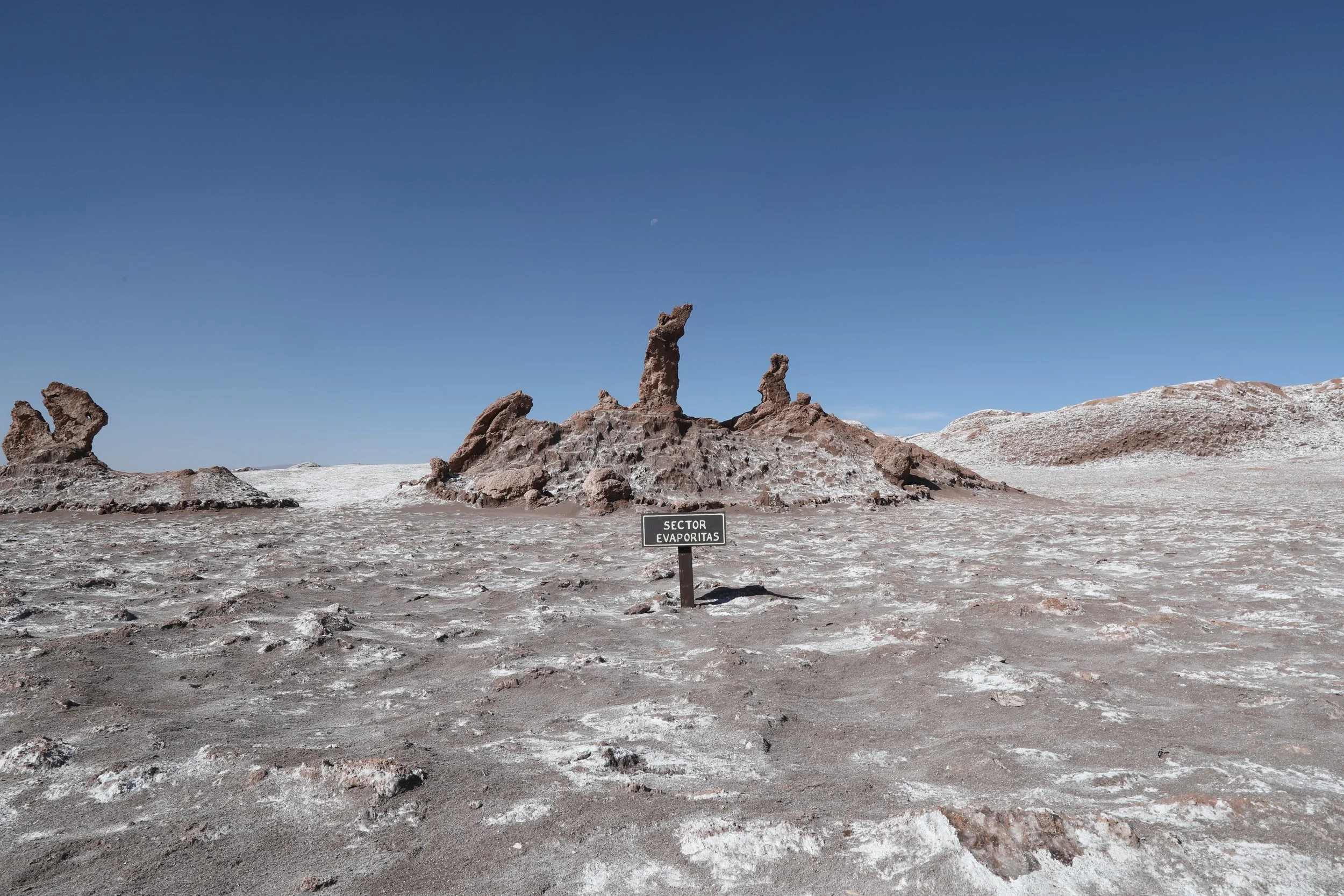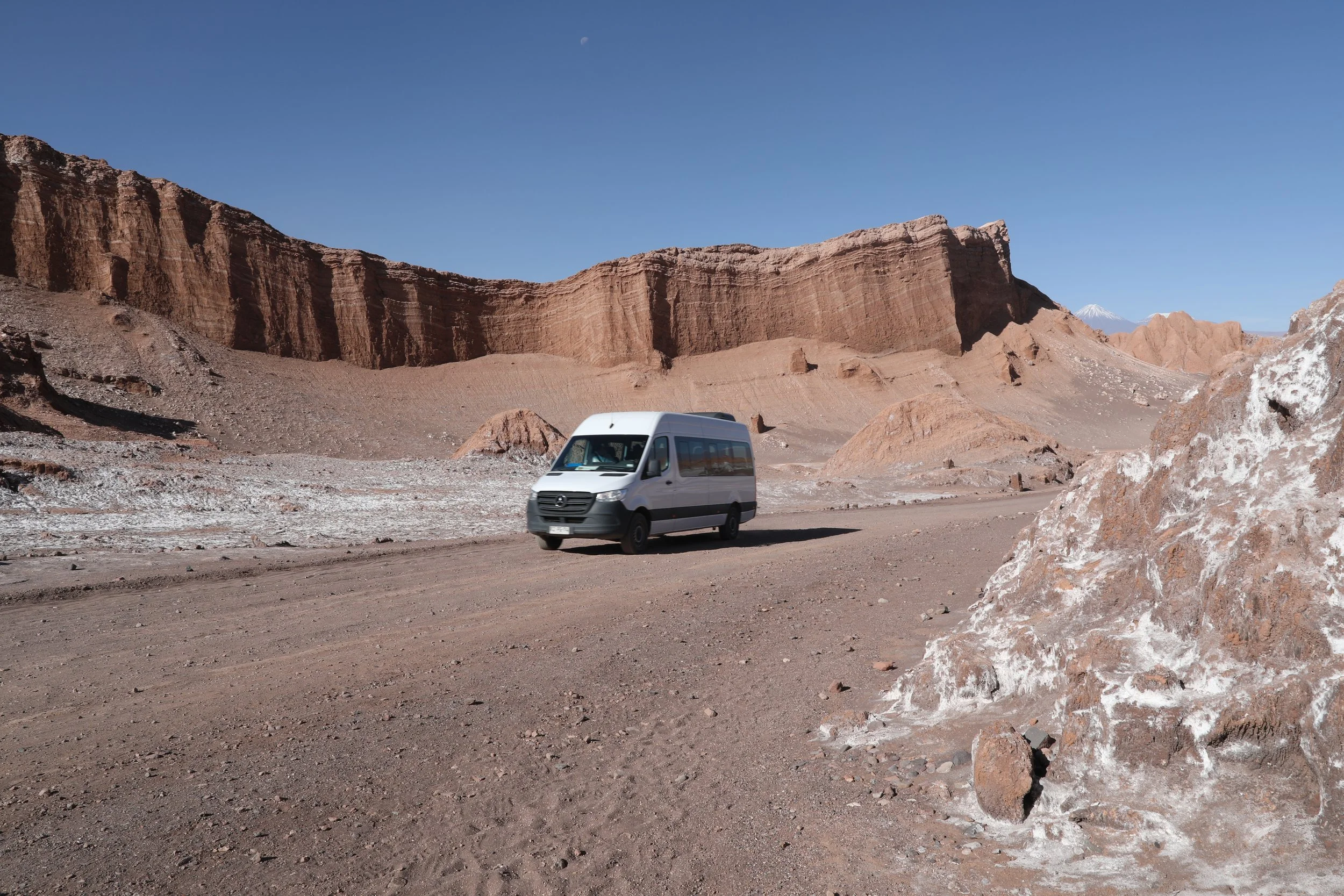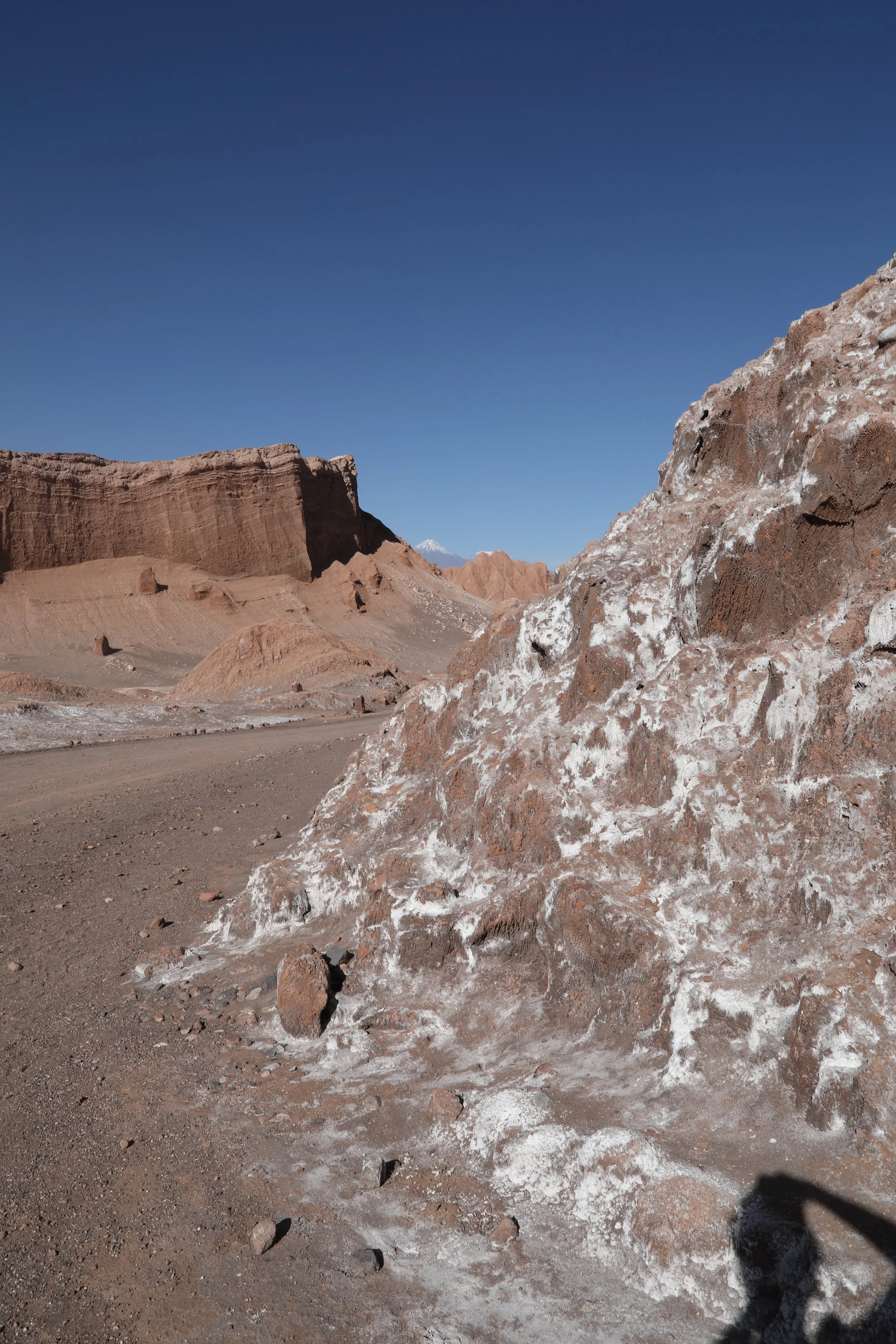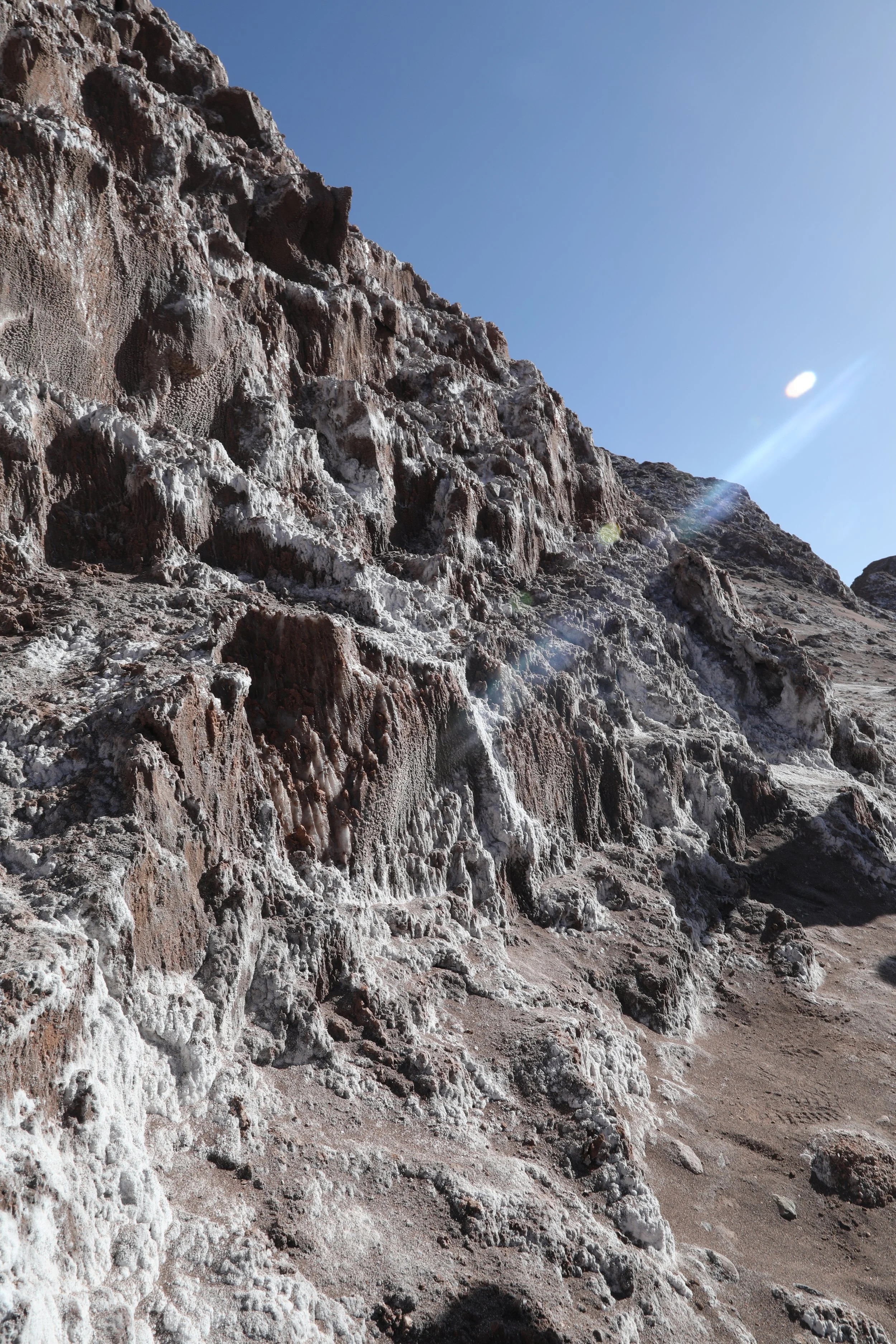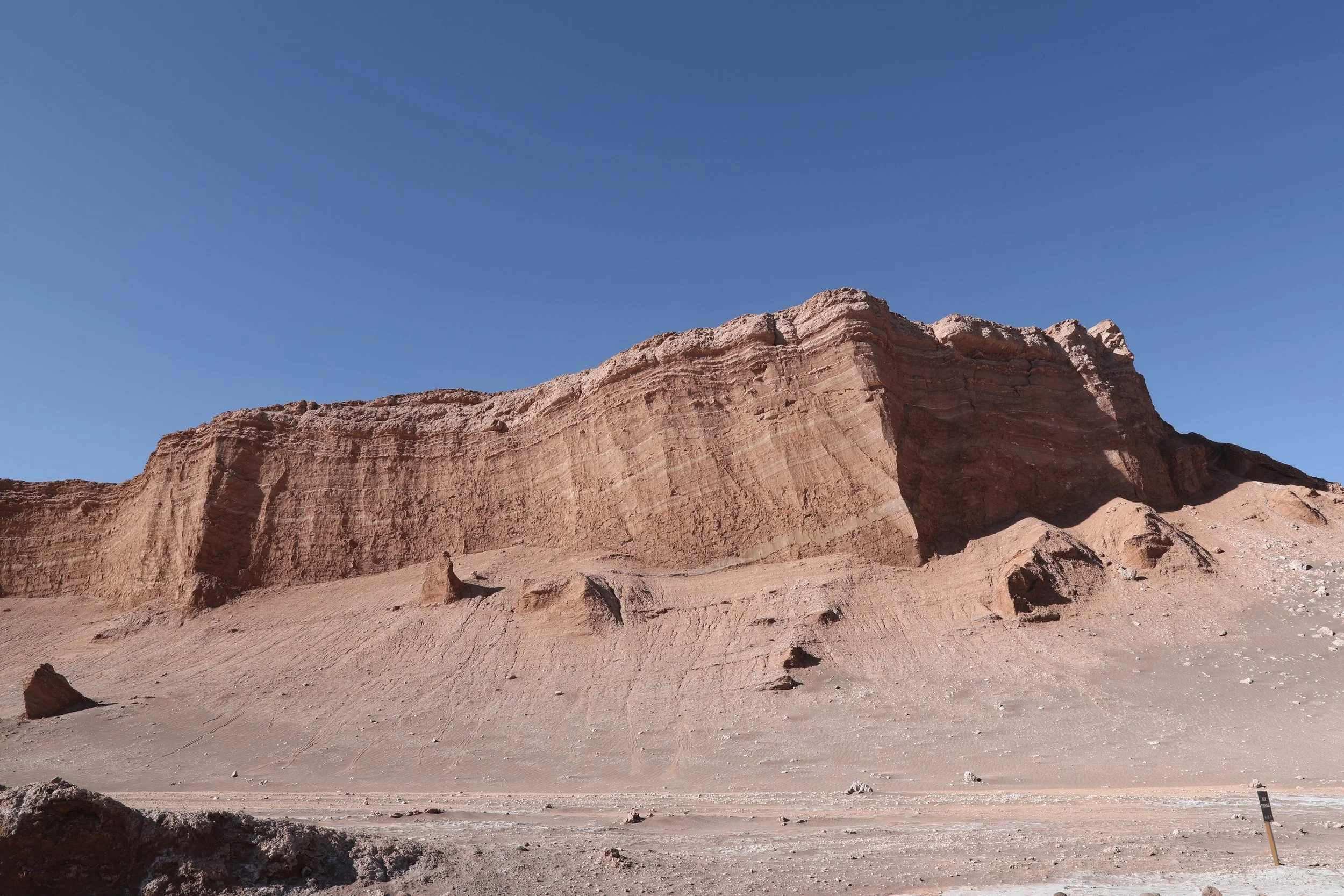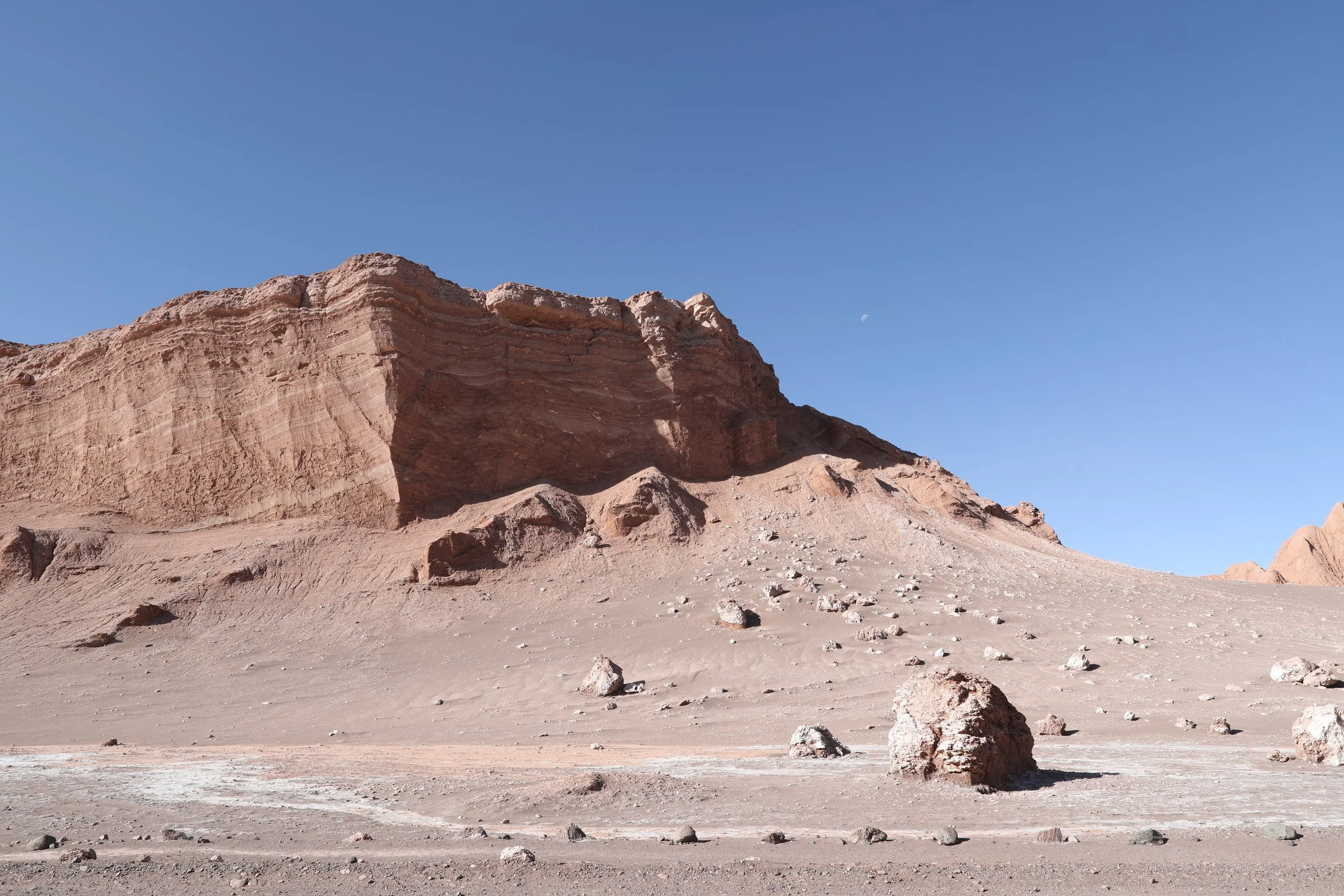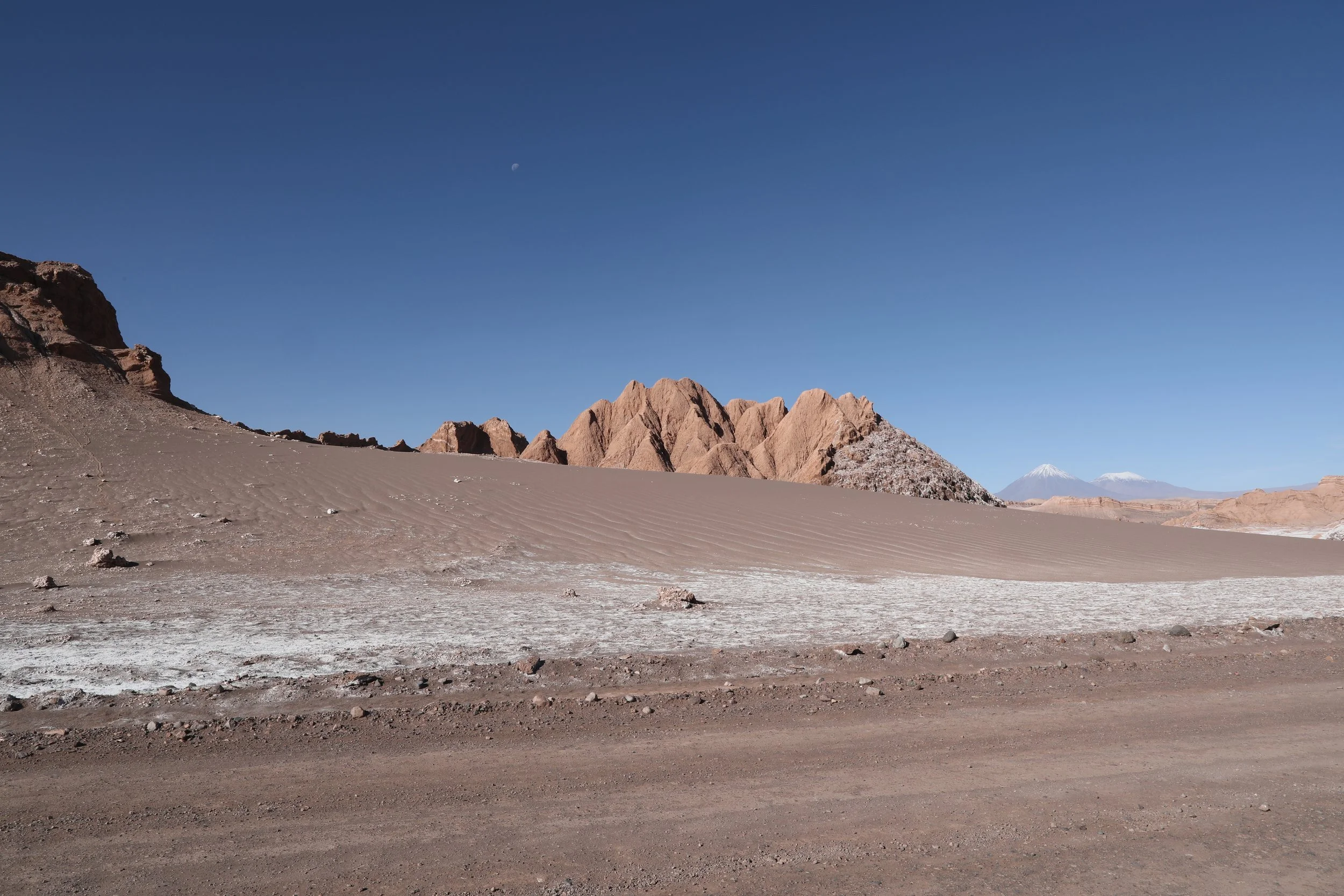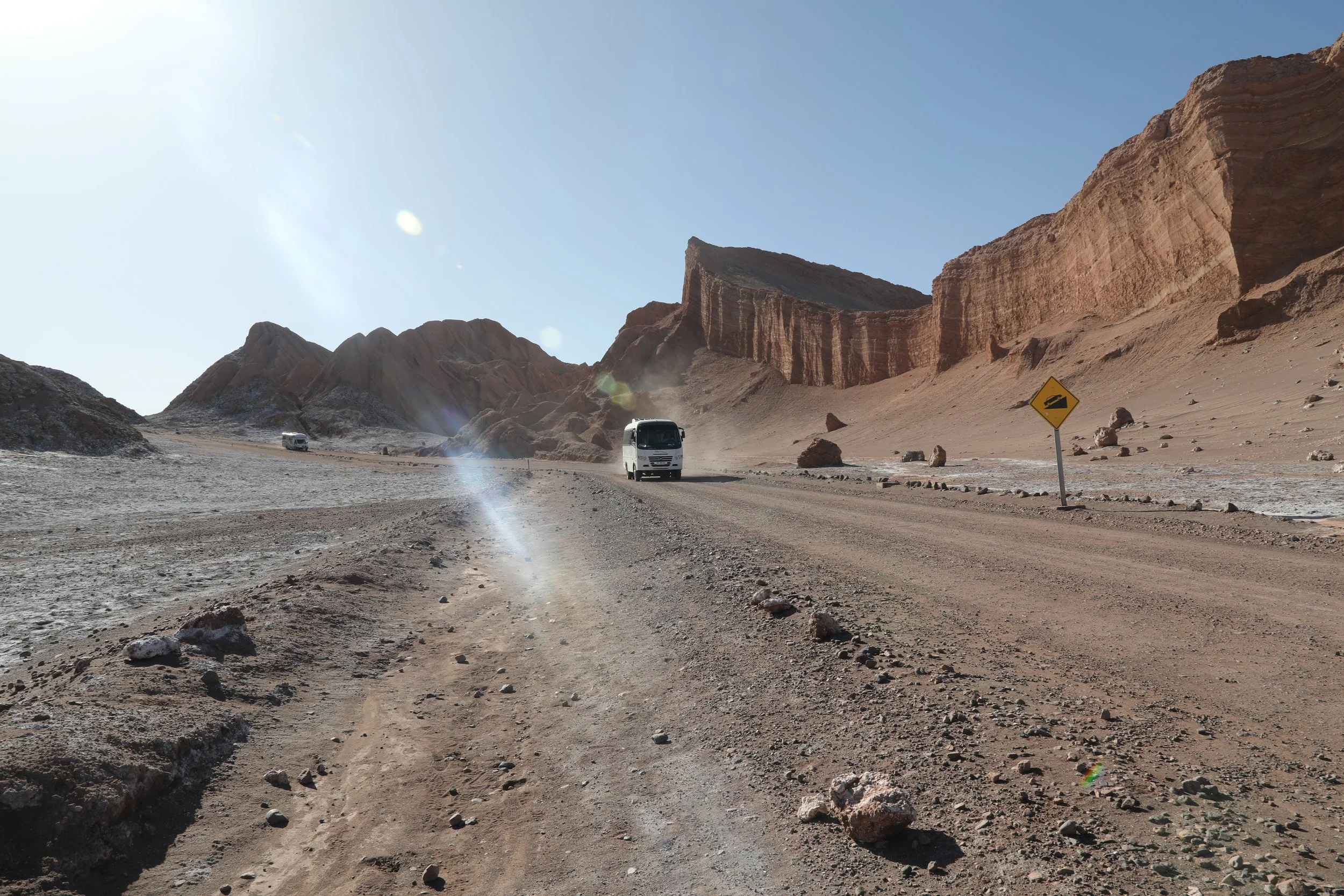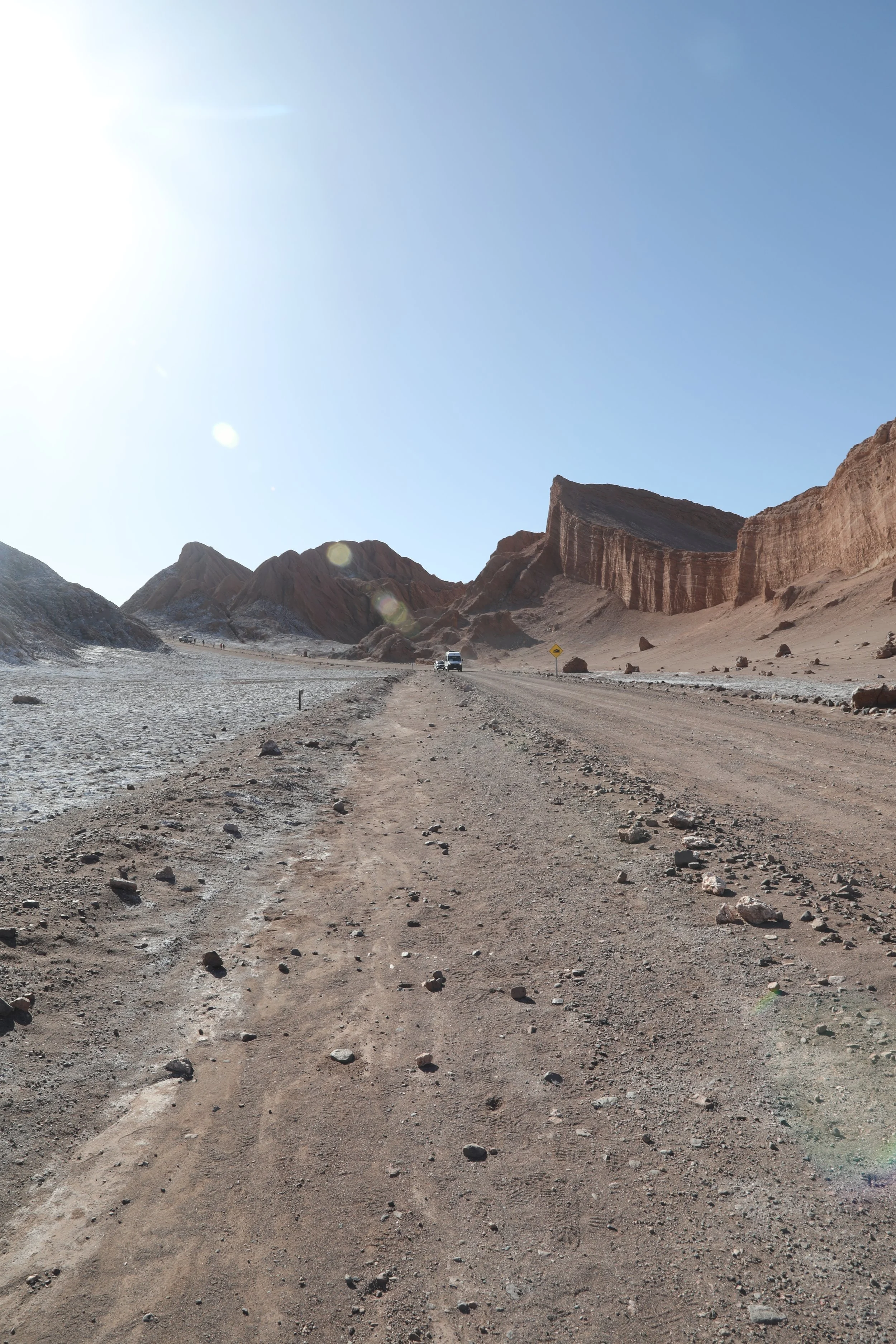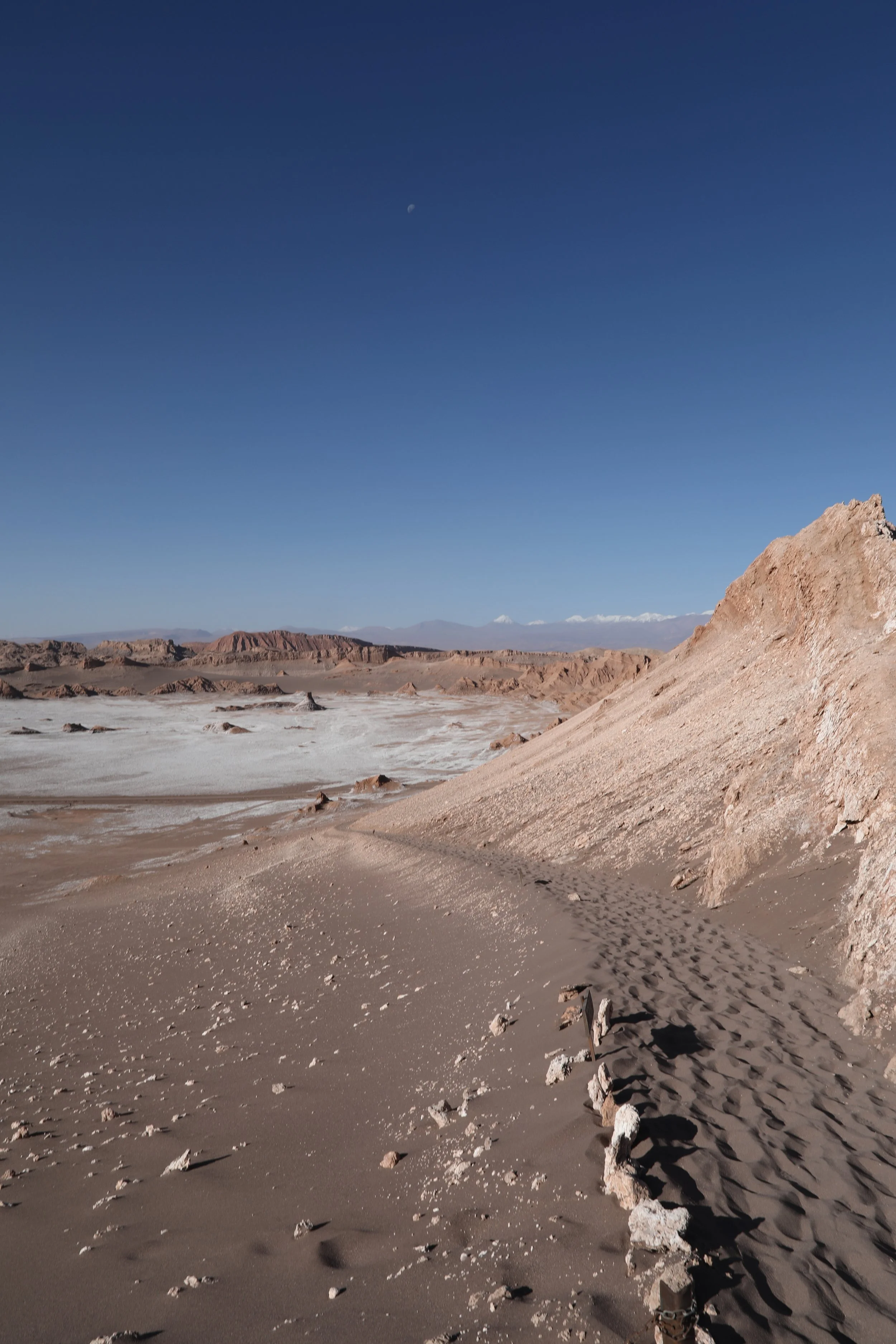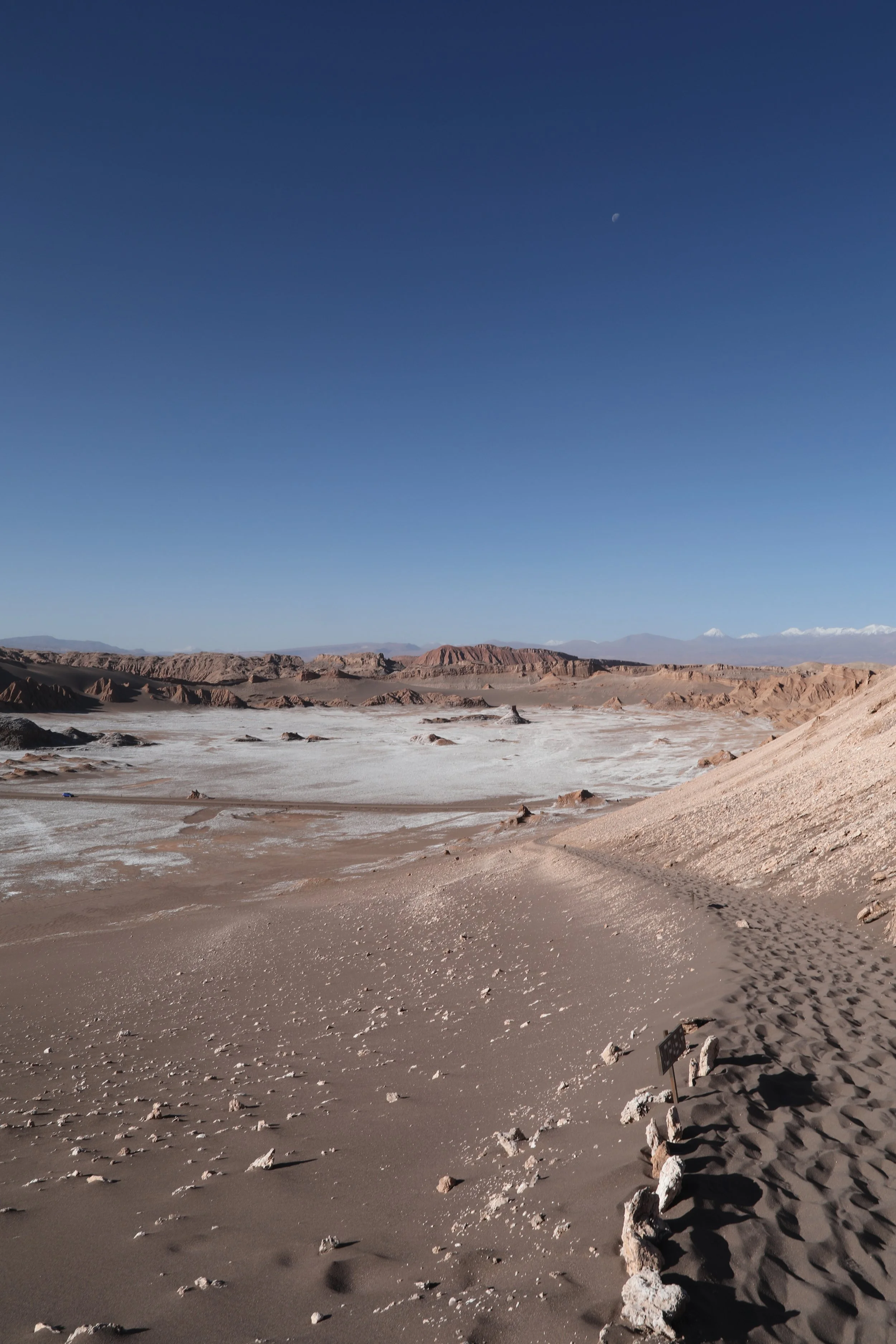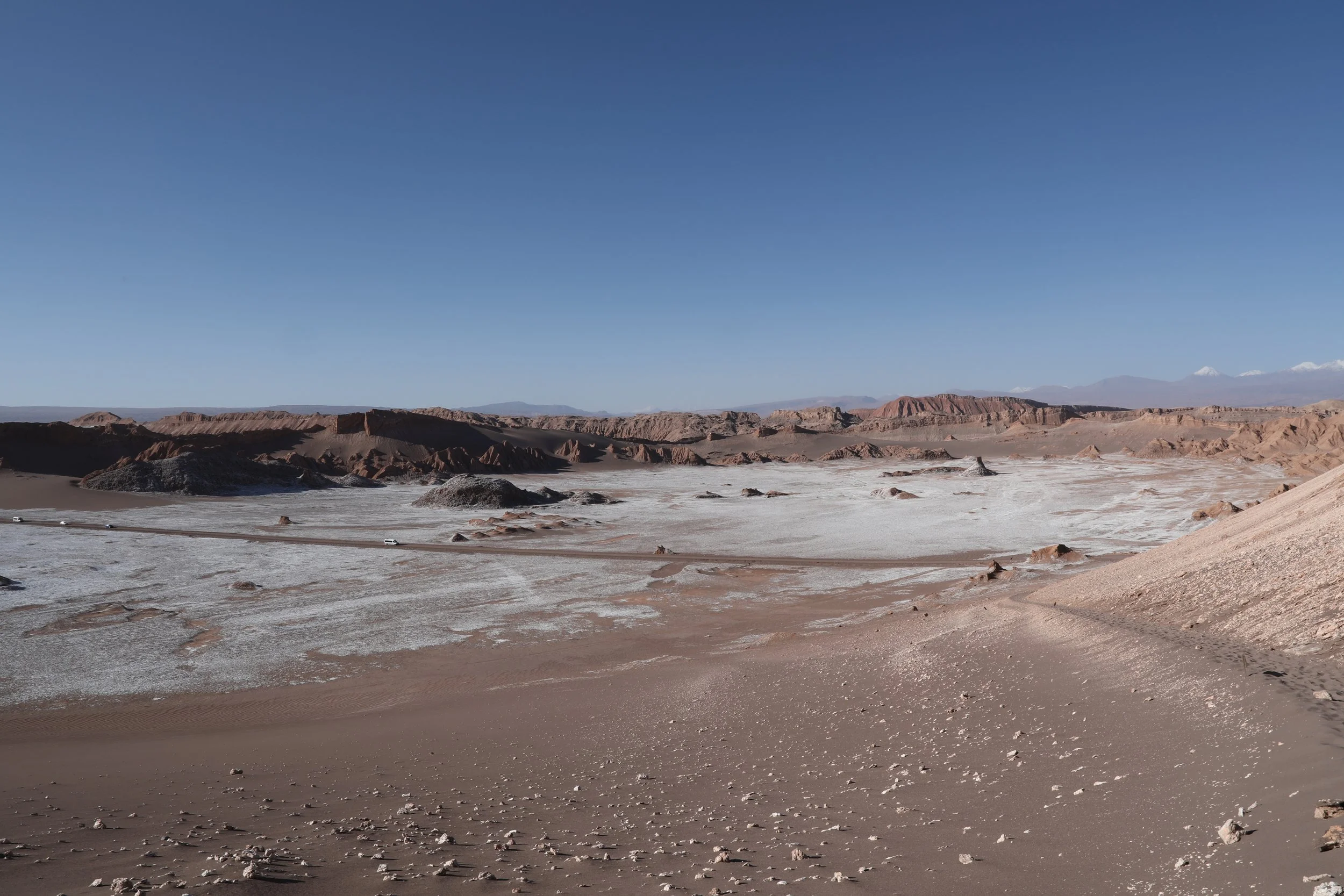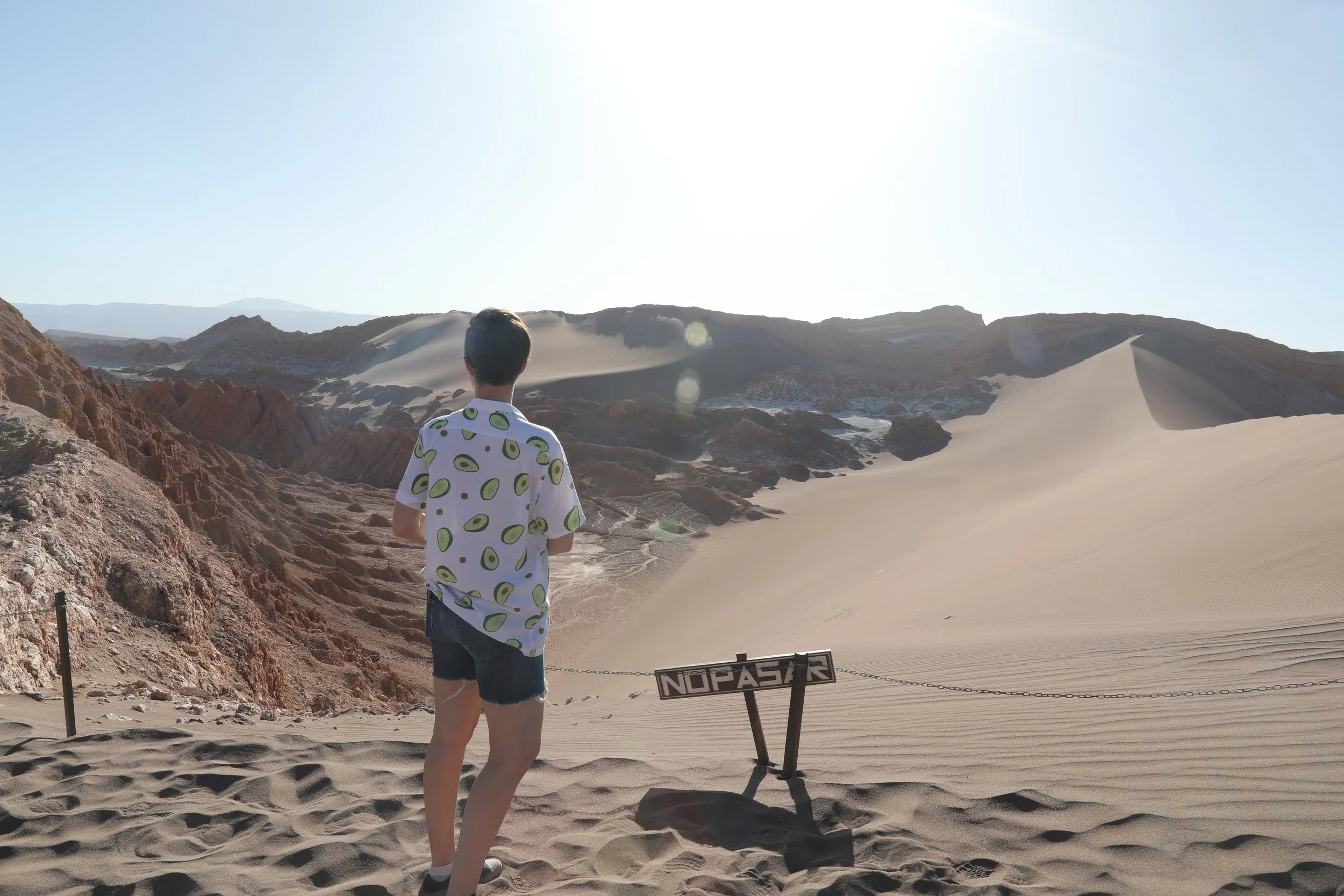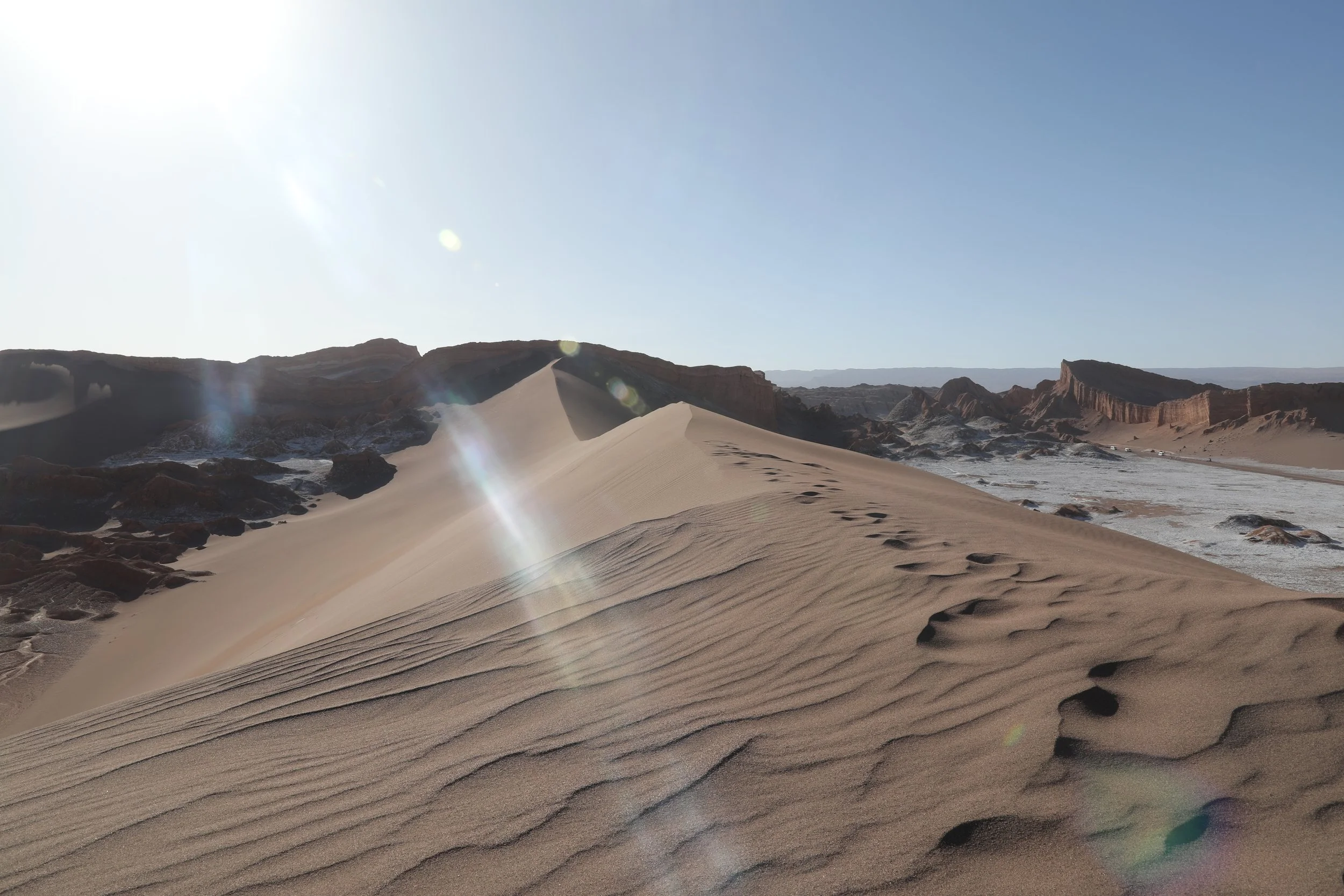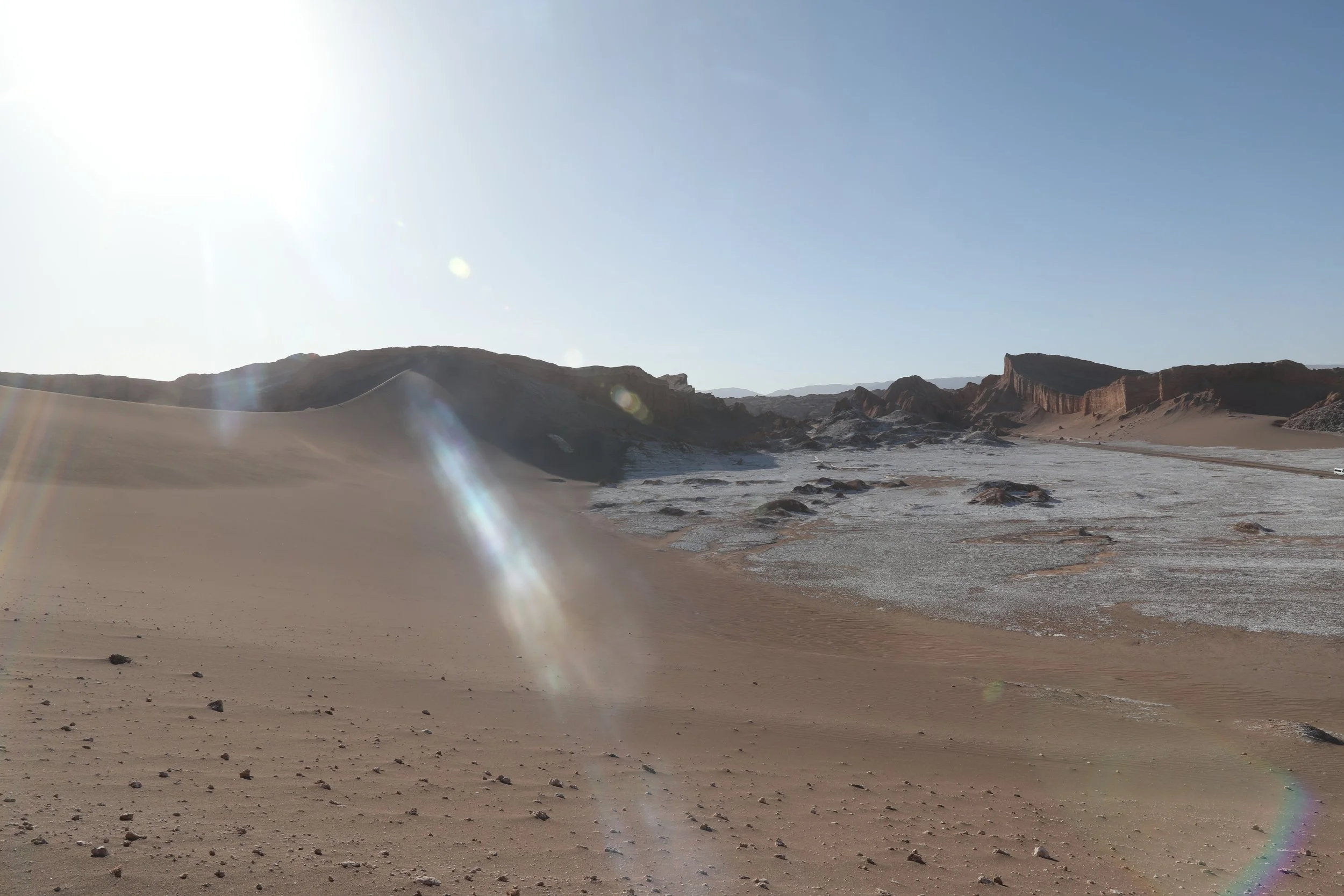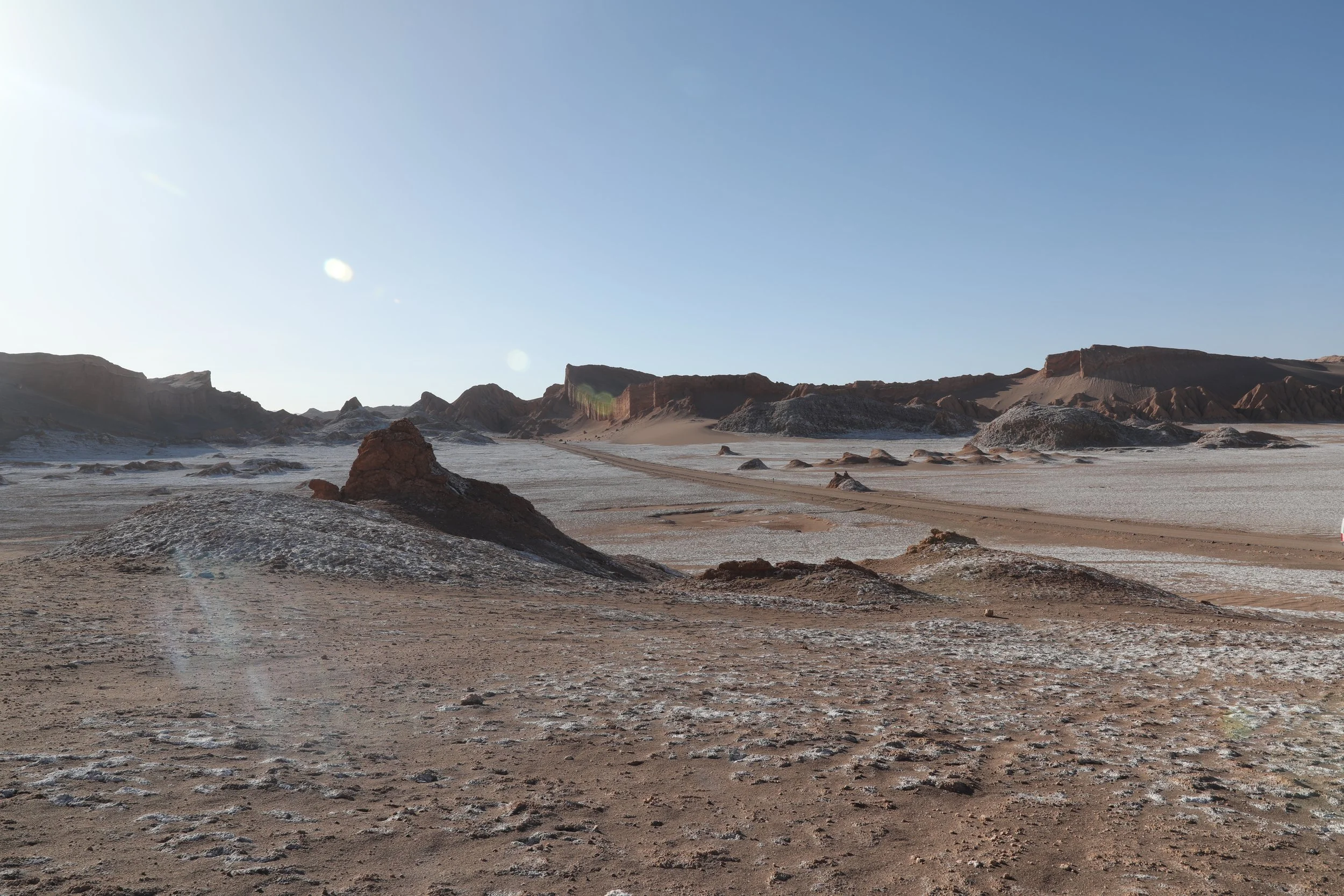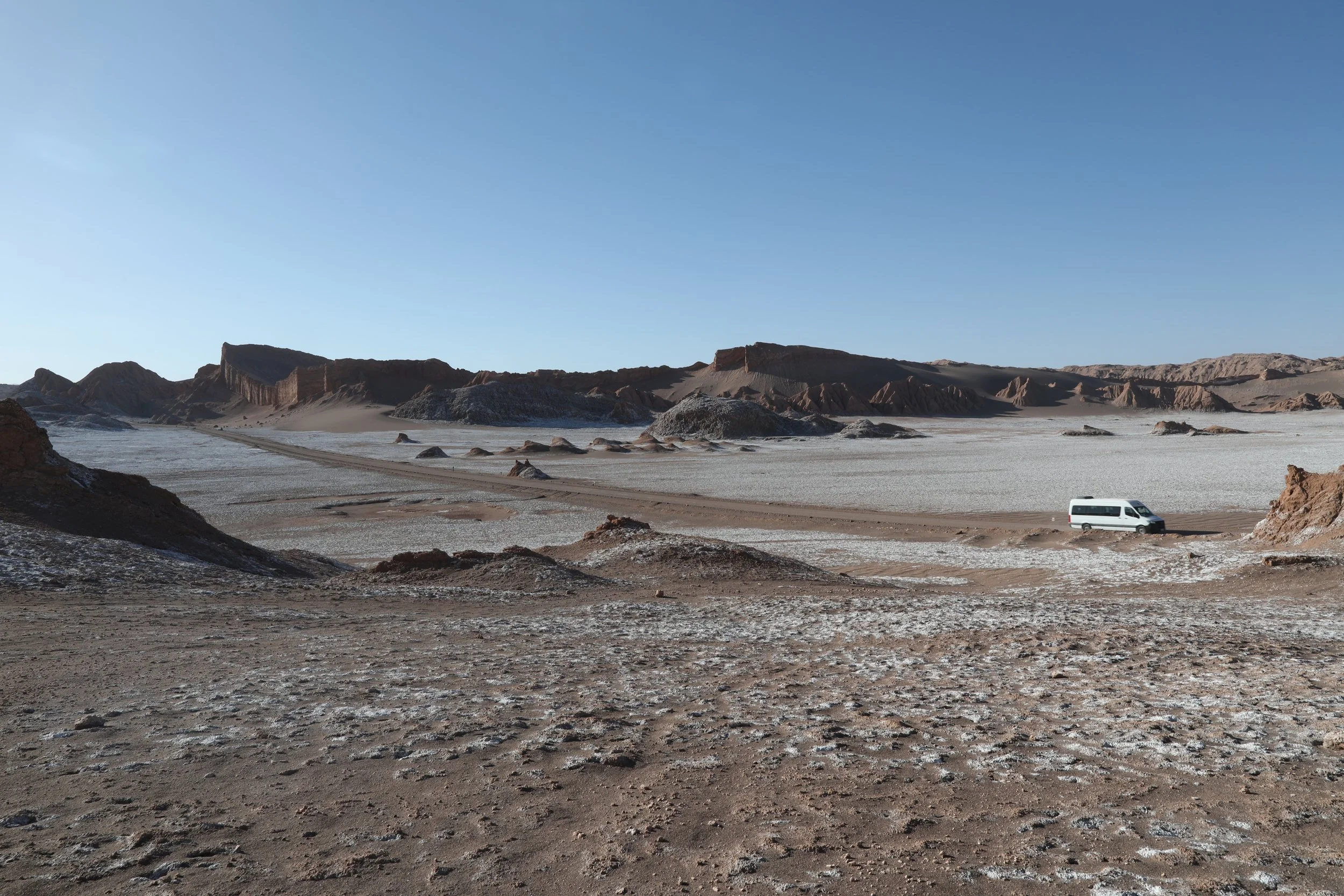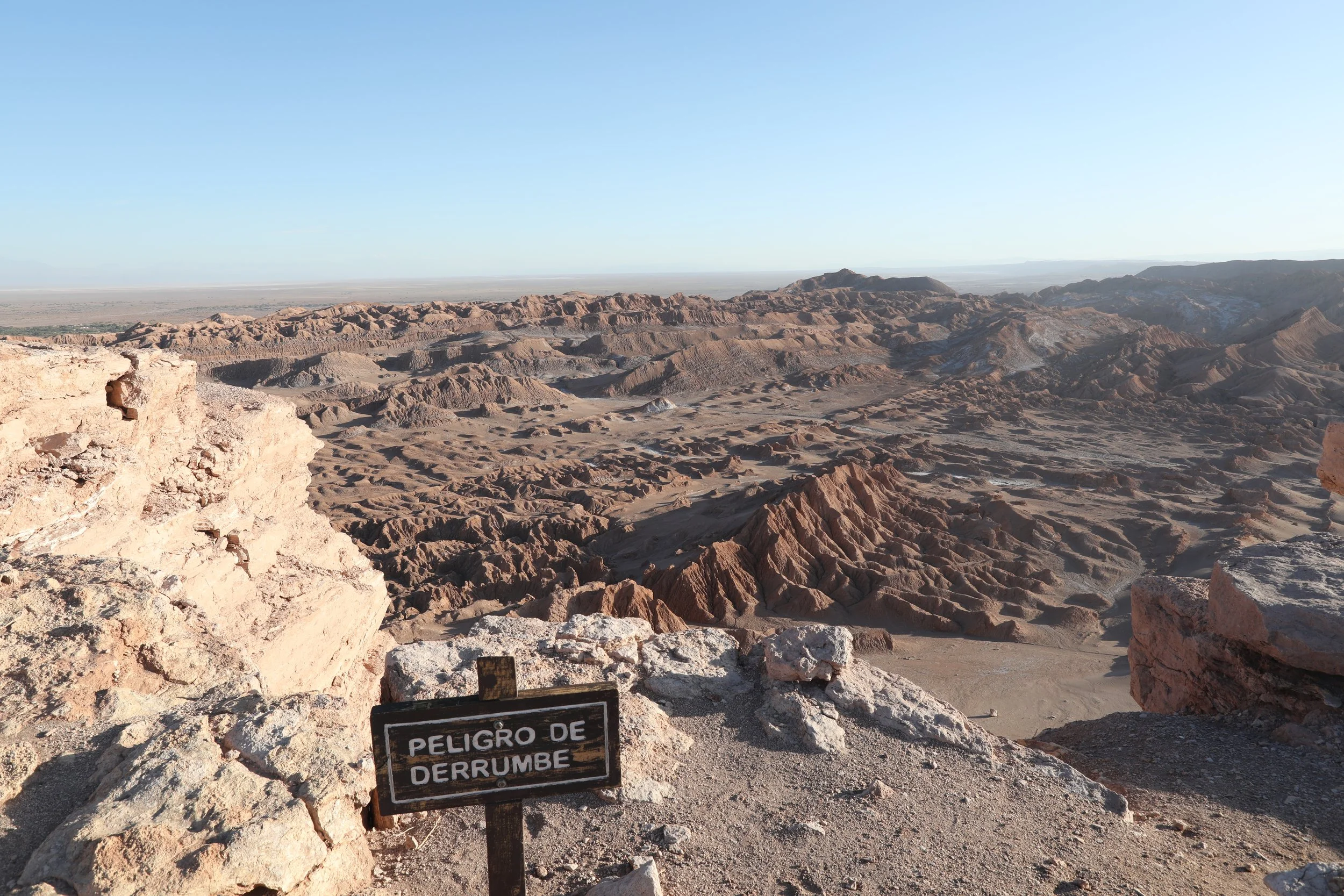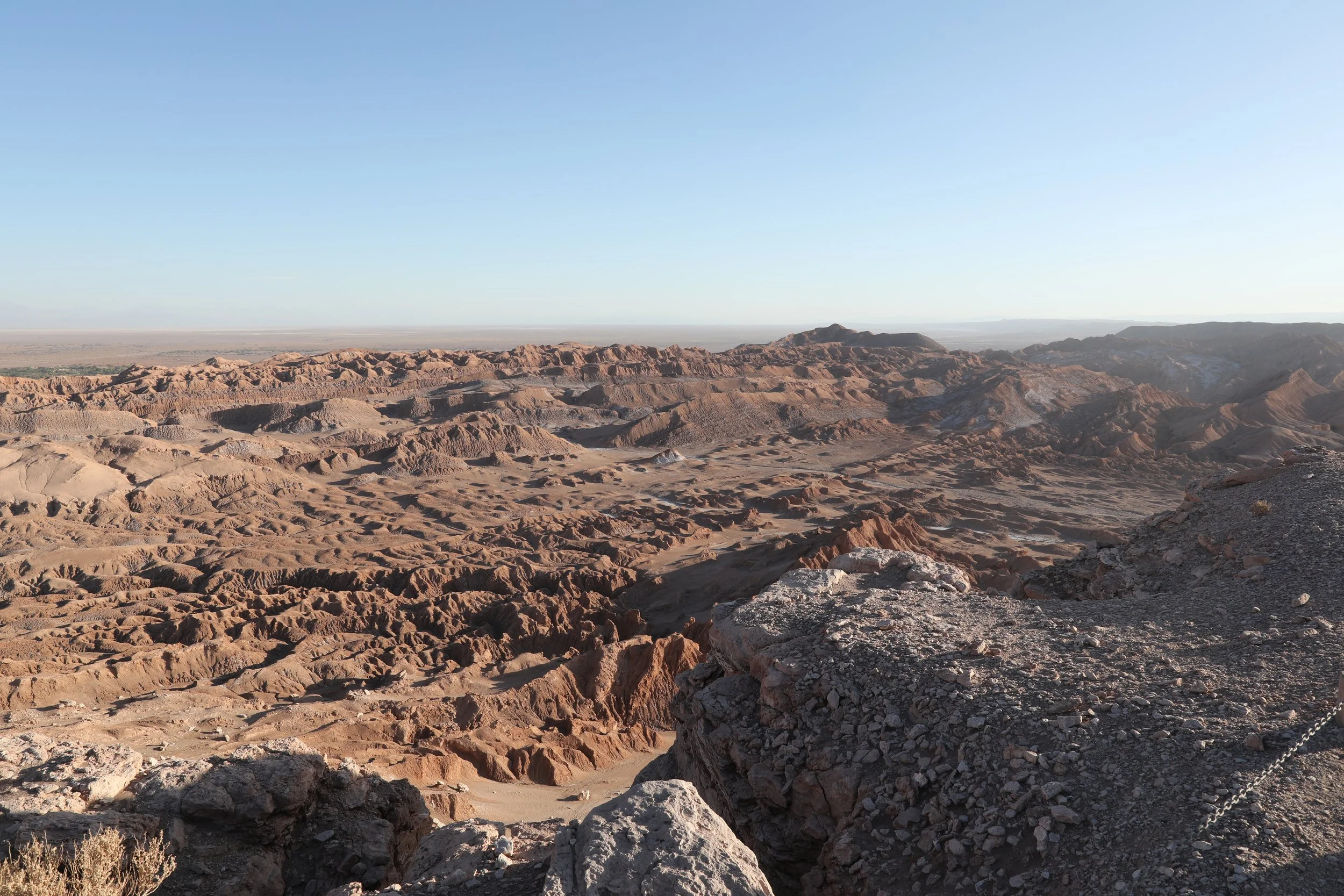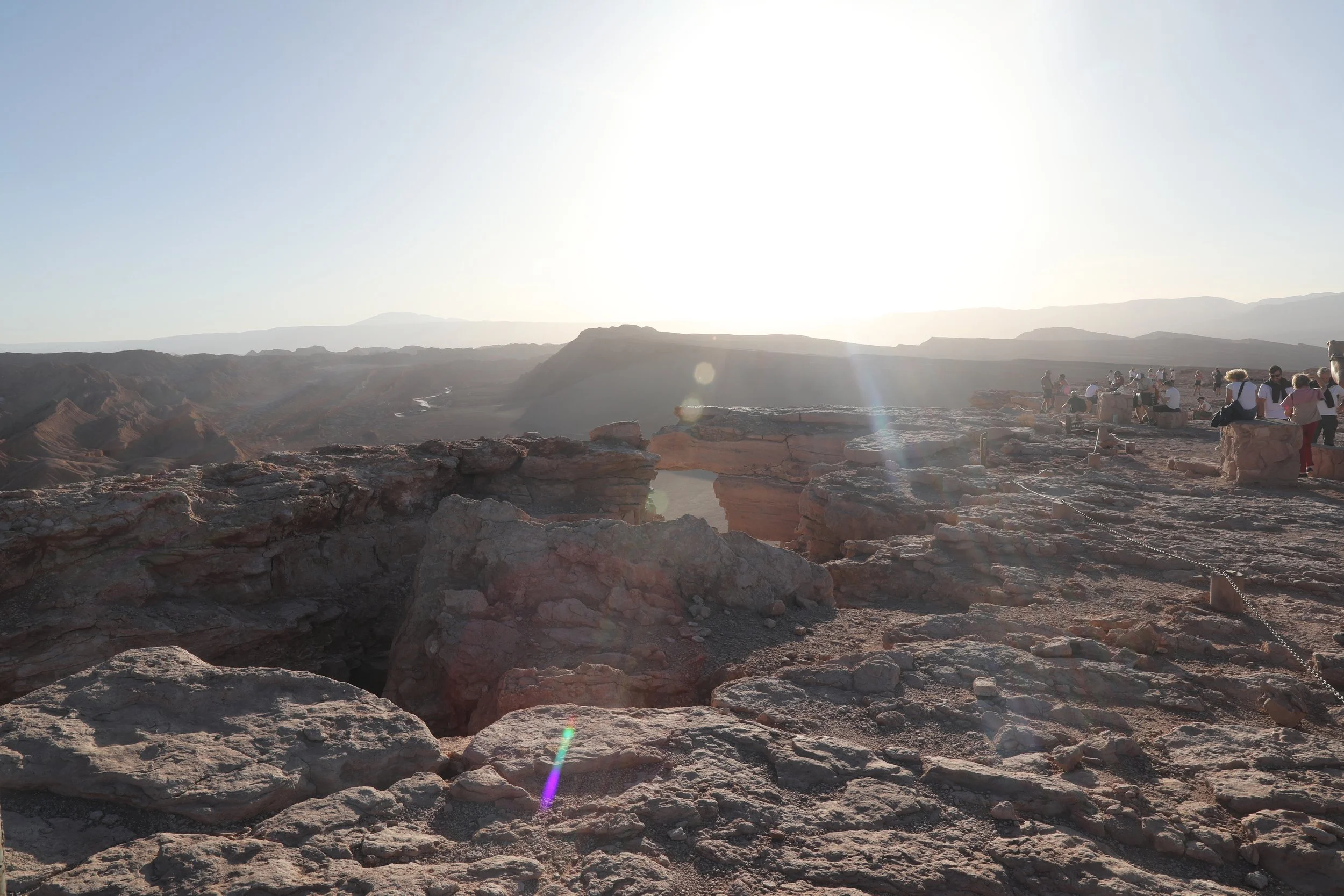Atacama’s Moon Valley
Best things to do in Atacama’s Moon Valley: explore its sandy dunes with this travel guide.
The driest place on earth.
El Valle de la Luna, or Valley of the Moon, is located eight miles west of San Pedro de Atacama in northern Chile in the Cordillera de la Sal in the Atacama Desert.
The region sits within Los Flemencos National Reserve and was declared a Nature Sanctuary in 1982 for its natural environment and unique lunar landscape from which its name derived. That landscape is filled with stone and sand formations shaped over time by wind and water, with beautiful colors and textures that resemble the Moon.
Appearing like manmade sculptures, salty rock formations spread across the landscape, sometimes dusted with a layer of salty white.
Otherworldly, El Valle de la Luna is a harsh region that should be respected.
Our time in Atacama was bookmarked by several other incredible destinations within Chile. Exploring the country for a few weeks was quite an undertaking, including eight flights, countless bus and taxi rides and even a ferry.
Exploring Chile began at its center in the capital city of Santiago, for its delicious (and hangover free) Chilean wine, world class cuisine and undeniable art scene.
From the capital, we moved north to San Pedro de Atacama, joining a handful of incredible tours to places like Laguna Chaxa, Piedras Rojas and Altiplanic Lagoons, the Andes Mountains for the El Tatio Geysers, northern Atacama to moonwalk at Valle de la Luna and the Atacama desert to stargaze into the deep blue sky.
Moving south, we flew to the tip of Chile’s southernmost Patagonia region and gateway to Antarctica, Punta Arenas, then on to Torres del Paine, with an exciting opportunity to experience Patagonia’s waterfalls, icebergs and glaciers.
Lastly, our journey led us to Castro on Chiloé Island, land of myth and sea.
Best Things to Do in Atacama’s Moon Valley
Set Eyes / On Three Mary’s rock formation
Stroll / Through Moon Valley Amphitheater
Hike / Moon Valley’s peak for scenic views
Catch / Panoramic views at Piedra del Coyote
Enjoy / Sunset over Valley of Atacama
Best Things to Do in Atacama’s Moon Valley
Set Eyes on Three Mary's Rock Formation
Exploring northern Chile with San Pedro de Atacama as our base, we opted for local tours to pack in as much discovery and exploration as possible. Our limited time in the desert had us moving between two tour agencies in town, Turismo Gato Andino and Horizons, to book all the activities our hearts desired for the next few days. This morning, we woke early for a sunrise tour to El Tatio Geysers and would join a stargazing excursion late in the evening. Each of our tours ranged between $40-$90 USD, depending on length and frills.
Tip / Bring sunscreen, lots of water & a jacket for when it begins to cool.
So, in the afternoon we joined a Valle de la Luna tour with Constantine and Marco. It was a quick 10 minute drive into the valley from town. As we entered the valley, our guide explained that we’d head toward the rear and then make our way back toward the entrance from which we came from. Along the way, there would be several viewpoints and we’d end the tour with snacks under the desert sunset at nearby location.
Three Mary’s rock formation is a series of three granite and clay formations that jut out of the ground, resembling sculptures of women, hence its name, “Three Mary’s” or Las Tres Marias. The three formations stand close together and are joined at the base, giving the impression of three distinct figures.
Tip / Stay inside the designated area & respect the land. Leave no trace (or you’ll get yelled at).
Stroll Through Moon Valley Amphitheater
By foot, we moved into the valley’s Amphitheater, a naturally formed rock formation characterized by a large, bowl-shaped depression surrounded by steep rock walls that create a visually striking amphitheater-like landscape. Considered one of the most iconic features in the area due to its lunar-like appearance and massive scale, visitors often hike this area to experience the dramatic scenery, especially during sunset when the colors of the sky create unique lighting effects on the surrounding rock.
Part of Reserva Nacional Los Flamencos (Los Flamencos National Reserve), the valley showcases extraordinary lunar-like landscapes sculpted by millennia of wind and water erosion, including salt formations, dry lakes and distinctive rock formations like the Amphitheater.
The valley’s (sedimentary) rocks are made of layers of clay, silt and sand which are easily influenced by wind and water, forces that have shaped the valley’s soft clay and sandstone rocks into remarkable shapes and features like canyons, ridges and spires. Additionally, the lack of vegetation has allowed erosion and weathering to shape the desert’s valley with ease.
Other geological processes occur, as well. The process of chemical erosion, also known as chemical weathering, is one that breaks down rocks and other geological features through chemical reactions. The area's volcanic activity and weathering of pre-existing rocks contribute to the presence of chemical elements like sodium and chlorine, which form salt minerals. The endorheic, or closed, nature of the basin allows for "recycling" of these chemical elements, with salts dissolving and redepositing during rain periods.
The valley's unique landscape, with its pointed ridges, hollows and gray and ocher-colored mounds, resembles the surface of the moon. And it’s dry and forbidding terrain is often compared to life on Mars. In fact, NASA has tested Mars rovers and other space vehicles in the valley, where its extreme dryness and soil chemistry is similar to Mars. The region itself is some 25 million years old and coined the driest place on Earth, as some areas have not received a single drop of rain in hundreds of years.
Historically, miners recovered salt from the region, along with other minerals like copper. However, today salt is gathered from the sea and men no longer mine the valley. The valley's salt deposits are due to the volcanic activity and weathering of pre-existing rocks.
And although home to the Salt mountain range, it’s rare to witness large deposits of salt in the valley, as we did on our trip. The Salt mountain range, or Cordillera de la Sal, reaches an elevation of 8,609 feet and was formed by the consecutive folding of an old salt lake that eventually dried and was forced upward by the movement of tectonic plates.
Valle de la Luna has an impressive range of color and texture and is home to dry lakes where the composition of salt creates a white layer on its surface. Salty protrusions appear like man-made sculptures and when the sun begins to sink they define the landscape.
One last piece to look for while exploring the area are fossilized imprints of ancient marine life. If one would be so lucky…
Our tour of the Amphitheater was coming to an end and thoughts of rest were in my mind but no such luck.
Moving away from the road and into deeper softer sand, our guide led us upward.
Hike Moon Valley’s Peak for Scenic Views
Up we went, climbing the sandy dunes. I couldn’t wait for what lie ahead: 360 degree views of the surrounding landscape.
It was a tough hot climb but one by one we made our way toward the top. To one side was a steep cliff, while the other had rolling hills of soft smooth sand, only disrupted by rocks and debris that seemed out of place. Small wooden posts let us know our boundary.
Once at the peak, it was abundantly clear why the valley is often compared to Mars. For as far as the eyes could see, reddish brown clay and sand swept across the land, while salty white remnants settled in the flat areas. The region’s name, known as "Cordillera de la Sal," comes from its rocks that possess a great quantity of calcium sulphate, giving them the appearance of being splashed with salt.
In the distance were taller mountains, the Salt mountain range, with salty white tips poking into the clear blue sky and a single road splitting the valley in two. Closer, was a rock formation shaped like the spine of a lizard, pokey and jagged.
More wooden posts, with chains this time, marked the edges of the peak and areas not to step. A ranger sat quietly in the shade under a small thatch structure. I wondered, exactly, what is her job?
Amazed and awestruck, we swallowed the beautiful surroundings, like one big gulp of water and admired the contrast between the sharp rock formations and the buttery soft dunes. How did they decide to coexist in this place?
More about the region: Valle de la Luna sits about eight miles west of San Pedro de Atacama in the Antofagasta Region, one that grew over centuries, around an oasis in the Puna de Atacama, or arid high plateau. Its first inhabitants were the Atacameños, who developed methods of weaving and ceramic pottery.
Classified as a cold desert, the town lies at an average elevation of 8,000 feet, often giving visitors mild altitude sickness with dizziness, sluggishness or headaches, so it’s pretty important to acclimate to the region before going on any hikes, especially in the heat.
The local climate is extremely dry and mild, with daytime temperatures between 77–86°F in the summer from December to February and 64–77°F in the winter from June to August. Nighttime temperatures are extreme and routinely drop below 32°F, reaching as low as 14°F in the winter.
Though not shockingly hot temperature-wise, the dryness and elevation of the region really do a number and affect being active and outdoors. On my first day in Atacama, the tops of my ears blistered and burned from merely walking around town, so we learned to be prepared from then on.
The climb down the dunes was much easier than the way up. Our group met back down at our van, excited to see what lie ahead. Dry, sunny and salty, Valle de la Luna was like nothing I’d seen before. It was desolate, hot and still other the dust kicked up from the large white passenger vans as they drove by.
Catch Panoramic Views at Piedra del Coyote
Overlooking the entire valley is Mirador de Kari, or Piedra del Coyote, a rocky mountain plateau with an overhanging rock similar to the one seen on Looney Tunes with Wile E. Coyote and the Road Runner (nickname was given by tourists).
El Mirador de Kari is located about 8,350 feet above sea level and is one of the most famous viewpoints in San Pedro de Atacama. Wind, water and temperature have combined forces to produce a ravine that’s truly out of this world.
From high up, it was wild to witness the extent of Valle de la Luna and quite bizarre to see the line in the distance where it simply, quit, smoothing out into a more regular flat landscape, at least until the mountains rose in the distance.
The loose dirt and pebbles seemed to crumble below our feet and the edge of the cliff didn’t feel solid. Cracks and crevasses made their way toward the visitors but no one seemed to notice much. Still, the views were mesmerizing.
Enjoy Sunset Over Valley of Atacama
For our last adventure, we enjoyed sunset over the Atacama Valley and views of the Salt mountain range. Made of salt, gypsum and chalk and known for its unique rock formations and natural sculptures, the range was formed millions of years ago when the bottom of an ancient lake rose.
While distracted by the view, our guides set up a delicious spread of fresh juice, wine, fruit, olives, cheese, nuts, chips and guacamole.
In no time, the sun began to set against the mountains, casting a pink hue on its peaks. Its salty tips still shining white.
The evening wound down and we made our way back to into town. Later in the evening, we’d head out for our astronomical tour.

